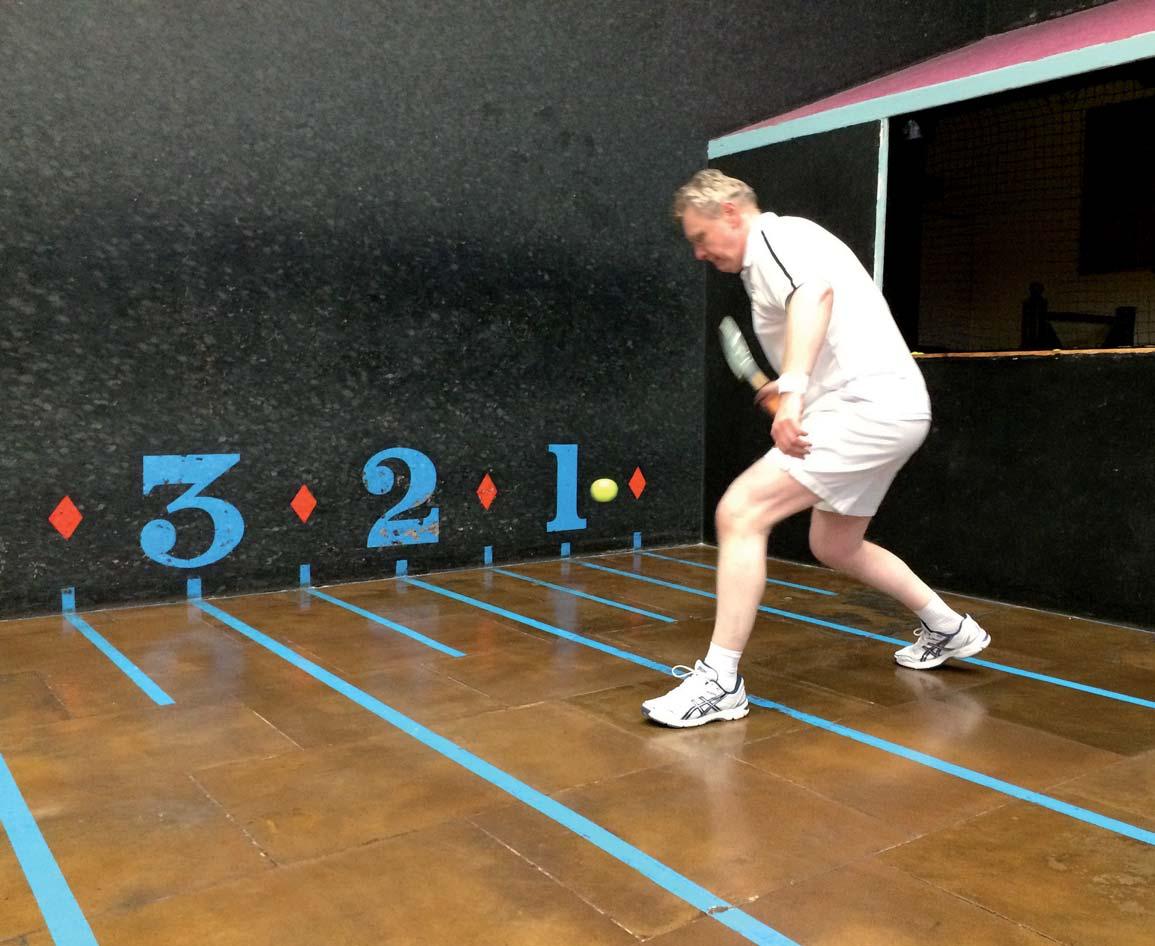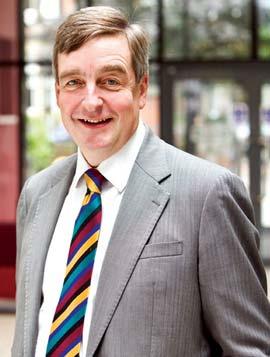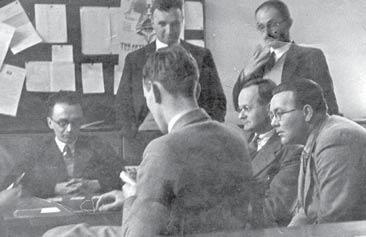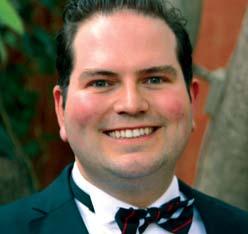
9 minute read
A History of the RGS in Its People
from ONA 96
A HISTORY OFTHE RGS IN ITS PEOPLE
by David Goldwater (51-62)
Advertisement
A History of the RGS in Its People has concentrated on those ‘who have gone before us’, but, as a complete change, I have thought for some time that there are iconic ‘RGS characters’ who are still very much around. No-one personifies this more than my tutor, Bill Elliott (52-88) – ‘WGE’, ‘Wedgie’, as well as other monikers! I recently looked over the school field from a balcony at one of the brilliant new sports buildings and it was almost the same prospect as that from the upstairs in the old Woodwork/ Biology building – how things at the RGS have changed… and yet, here I was, sitting with Bill in his warm lounge in Benton, 63 years after he had been appointed to run, ‘the Woodwork department.’
After his father was appointed works manager at Joseph Lucas, Bill and family moved over from Manchester to Newcastle, apparently, in a Belsize Bradshaw car, clearly an important family journey. At Gosforth Secondary School, disliking the raw vegetables served at school lunch, he opted each day to sprint home to Forest Hall for lunch and back, thus beginning his love affair with the running track. Loughborough came next (1944-46) where Bill captained cross country (holding the cross country record for five years) and ran for the Universities Athletics Union team. After joining nearby Nottingham University’s Air Squadron, flying de Havilland Tiger Moths and American Harvards, Bill, as a member of the RAFVR and the Officers’ Training School at Hereford, was selected to train as an RAF pilot in Bulawayo, Southern Rhodesia in 1946.
Lured by the 1948 Olympics and the contact with top athletes, after two years he returned to Loughborough to study for his Diploma of Loughborough College qualification. His appointment at Blyth Grammar School in 1949 brought Bill back to the North East. Here, he was in charge of Woodwork and shared PE.
After three years, an appointment in the Woodwork department came up at the RGS and, encouraged by his father, Bill was persuaded to apply. At that time, school sports were primitive and included the sack race and throwing the cricket ball. Fortunately, he was given every encouragement to utilise his experience from Blyth and a standards system was introduced whereby every pupil was able to contribute towards House points. Many ONs will remember being able to take pride in winning even one point.
After the innovation of a pole vaulting pit and this entirely new sport at the school, JR McManus (45-54) achieved a Cambridge Blue and the indoor British record in the sport. This reflected great credit on the RGS and Bill still glows with pride as he recalls the visit by the combined Oxford and Cambridge Athletics Team (Achilles) for a day in 1955, coaching in the morning and competing on a handicap basis in the afternoon.
‘In the Fifth Form, as a strong fit kid who despite being good at it, did not like rugby, I at last had a choice for winter sport. I chose cross country, turned out to be quite good at it and went straight into the school team. There were then three happy years running for the school with many trips to odd places, all under the avuncular but inspirational aegis of Bill Elliott. He cared and he really wanted everyone to enjoy what we were doing and get the very best out of ourselves. He would reminisce about his own athletic prowess, running in Rhodesia or getting the entire Achilles Athletics Team to RGS earlier in his career. He knew how to bring the best out of you by making you want to do well for him but never hammering you if sometimes you did not. I recall a trip over to race in Cumbria when we went by cars and stopped off for a break on the way where Bill bought us each a glass of beer.

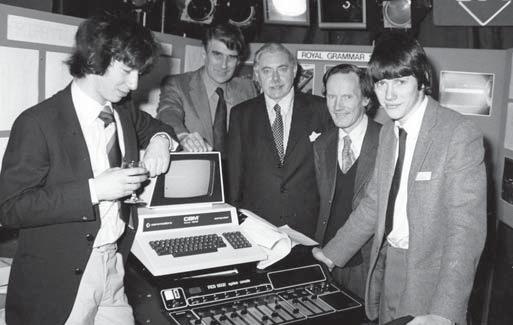
Top to bottom: The RGS Model Railway Club, circa 1956

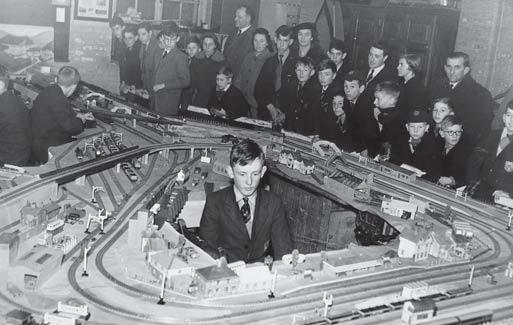
WW Kreshmarr (Achilles and German javelin champion) RGS, 1955
JR McManus demonstrates his prowess at the pole vault
RGS Sports Day as it was in the 50s to 70s
The theatre lighting project –Winner of the BBC Young Scientist competition, 1980 ‘Bill’s enthusiasm to impart to his pupils the appreciation of fine craftsmanship has remained with me throughout university and subsequent working life in a scientific career.’ Dr W Dave Waddoup (60-70)
Little things like that helped shape the way I later related to my pupils as a teacher. He is a lovely man and I am very grateful to him.’ Norman Shiel (60-67)
It was a constant battle at school with the cricket “high-ups” (as he calls them) concerning the overlap of his elliptical running track with that of the circular cricket boundary. The Athletics Team competed regularly with distinction at numerous championships around the UK. Bill acted as Chairman at both the Newcastle and Northumberland Athletic Associations. The Running Club gave many present-day ONs their life-long interest in the sport. In 1966, Loughborough College became a University and, Bill, together with John Elders (57-82 and 92-96) and Paul Ponton (71-09), were recalled and awarded degrees.
Moving on to Woodwork, as all students took the subject for three years and many at O and A Level, this subject seems to endure with and brings happy memories to a huge number of Bill’s former pupils. The opportunity arose when the then current Head would not allow Oxbridge entrants to leave after Christmas and several courses were offered in his and other departments, resulting in some spectacular successes. Bill singled out a remarkable cross-bow crafted by John Armour (52-60).
‘In Bill’s lunch-hour Woodwork sessions for the Sixth Form, I constructed a rather fine glistening white electric guitar, which Bill insisted that I show the then (Oxon Classics) Headmaster –largely in despair, I suspect, to remind him that valuable activities of a slightly less academic nature were going on, “Over there in the Woodwork block”. The Headmaster concerned conceded his rather sparing approval adding, as a throw-away afterthought, that, “Such subjects were ideal hobbies for gentlemen, but not to be carried too far!” Bill’s enthusiasm to impart to his pupils the appreciation of fine craftsmanship has remained with me throughout university and subsequent working life in a scientific career. It is now providing me with longstanding ‘hobbies’ which I am now indulging (when time permits) in my long awaited retirement. Another of Bill’s persistent mottos, which remains firmly embedded in my psyche, is that the, “Job is never finished until the clearing up is done”. Woe betide anyone who leaves any mess in my environment! So, many thanks Bill; happy memories indeed.’ Dr W Dave Waddoup (60—70)
Bill launched a Model Railway Club, with a huge layout exhibited on many a Speech Day. Bill Haden (60-72), on being approached about introducing the white-hot subject
of the age (technology), exclaimed, “There will never be any technology at the RGS whilst I am Headmaster!” New opportunities arose with the appointment of Alister Cox (72-94) as Head, but progress was slow until Frank Budden (60-80 and 80-82), the head of Maths, agreed to establish an A Level in Applied Mechanics for prospective engineers. The subject encouraged ingenuity and inventiveness, resulting in the building of a small hovercraft in 1974 which won 2nd place in the national championships. Three years later, a more advanced four metre racing craft was built, powered by a 600cc Reliant engine. Converted into a crop sprayer, at the suggestion of Paul Brown (73-78) and Alastair Wolf (71-78), this craft won the prestigious BBC Young Scientist of the Year competition. It was displayed in the Science Museum main entrance, eventually winning Joint First at the European Young Scientist contest in Eindhoven.
Quite a jump from the towel rails and stools many of us created with… ‘pride’?
‘Bill was simply tremendous as a teacher and I know many pupils had great affection for him, his mannerisms and sayings. It is perhaps noteworthy that some 30 years on his one-liners, teaching approach and his mannerism are quickly recalled by many –witnessed at the Applied Mechanics reunion at the Annual Dinner just over a year ago. (See Issue 93). Also, testament to the man, were the numbers that turned out for it. His classic line, “Wood doesn’t grow on trees, boy!” will be recalled by so many. Top man all round and a delight to have been one his pupils.’ Rob Blake (79-84)
‘I remember him so well, both as a teacher and a coach and as a warm, friendly man. Bill possessed tremendous enthusiasm and it was infectious. I certainly took to athletics thanks to his encouragement and I was privileged to be a member of the school athletics teams through all age groups. I was not so talented at Woodwork and I am so grateful to him for never laughing at my appalling efforts to make a simple pen- and pencil-holder. Thank you, Bill!’ Alan Castree (53-61)
In 1980, two members of the Applied Mechanics course invented a computerized theatre lighting system with help from the Physics department, winning the BBC Young Scientist Competition for the second time. Along with these projects, many highly sophisticated items were produced as aids to the handicapped. One of these was financed by the Prince’s Trust. The Applied Mechanics course ran for several years, launching many applicants into engineering with major industrial scholarships along with university fees.
‘I have very fond memories of Bill’s Applied Mechanics A Level classes. I took the A Level because I wanted to become an engineer and it just reinforced that desire. I went on to become a chartered engineer working across refineries, explosives factories, aerospace and blast furnaces worldwide. I thank Bill and the team for his
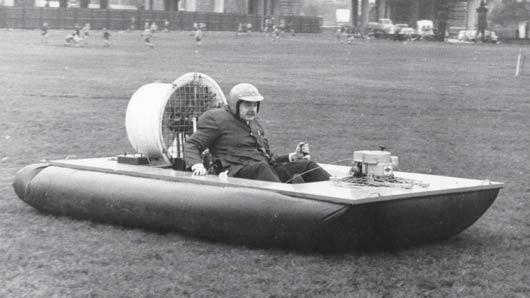
Above top: ‘Welcome home’ after winning the BBC Young Scientist of the Year 1978. (with the Faraday Trophy from the Royal Institute) Above below: Bill Elliott tests the ‘Blue Scarab’ hovercraft (placed 2nd in the National Schools’ Championships)

enthusiasm and dry wit. I loved the competitions he ran –the balloon-powered ceiling tile and making vehicles that would travel exactly five metres –and there was always something going on. Barry Malone (77-84) and I were a team that made kids toys for disabled children with buttons and levers etc., another of Bill’s projects. I’ve just designed and built a hovercraft with my son, from the ground up, inspired by the hovercraft at the RGS’. Phil R Thompson (77-84) writing from Australia.
In 1984 he was approached by Alister Cox who invited Bill to consider launching a Clay Pigeon Shooting Club which proved to be extremely popular, winning several Public Schools Championships and trophies.
Bill retired in 1988 and has remained busy writing and publishing several books on local history, particularly in the area he has lived now for approaching 90 years. A remarkable man, a great personality, a loyal ON teacher and a complete pleasure to be with. Very many Old Novos across the decades will, no doubt, be pleased to add, “And so say all of us!”

